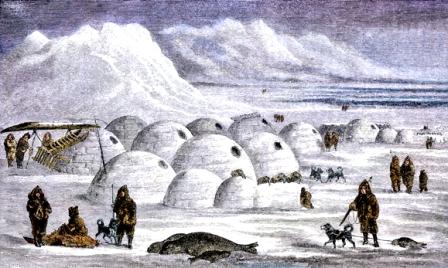Low temperatures are disruptive to human homeostasis since the human body has a relatively high core temperature (97.7 Fahrenheit). Decreases in body temperature leads to impaired bodily functions. Slowed blood flow, lethargic nerve responses, and muscle rigidity are symptoms of the human body succumbing to the forces of cold temperatures. A human being has a low chance of survival of this homeostatic disruption persists since it essentially makes one "clumsy", a "clumsy" person has a lower chance of successful endeavoring for food and shelter.
2.
a) Short Term: Goosebumps are a short-term adaptation to cold temperatures. Goosebumps produce extra heat by the muscle tension created from piloerection. Additionally, raised hair also increases heat insulation. Shivering is another short term adaptation that functions in parallel to goosebumps.
b) Facultative: A major trait of many cold environments is typically the lack of sunlight, thus in areas where temperatures are typically below zero degrees, people tend to have lighter skin. This mostly due to the imperative of vitamin D absorption.
c) Developmental: A great example of developmental adaptability is the Inuit people and their consumption of high caloric fatty foods. This significantly rose their metabolic rates which as a result, their bodies produced more heat. They also have actively lifestyles which supplements their choice of diet and their bodies are stocky and round as a result.
d) Cultural: Igloos are actually incredibly effective insulators of heat since they are essentially traps for small pockets of air. Snow, despite being cold itself is great at insulation since it can be compacted to the point where there is almost nonexistent intrusion of cold air from the outside. Thus, body heat by itself, can be used to bring the internal temperatures of igloos to a comfortable 40 degrees Fahrenheit (much better than the alternative which is below zero).
3. There are many benefits to studying human variation through this perspective across varying environmental clines. One benefit is primarily medical, hypothermia and hyperthermia are two common medical conditions that can be fatal if not properly cared for. Observation of adaptations by humans living in environmental extremes can aid with the treatment of these ailments.
4. Race is an ineffective use of categorization since it has caused a lot of controversy for the majority of human history. From a genetic viewpoint, human beings aren't that different from one another. Phenotypic differences are a result from the environment in which humans have adapted to. It is a much more effective and efficient way to understand human variation through the perspective of environmental adaptation because it decreases the amount of classification we succumb ourselves to. If people had higher scientific efficacy and understood this about how environment plays a major role in how we look, I personally believe that racism would not be as big of an issue as it is today.




